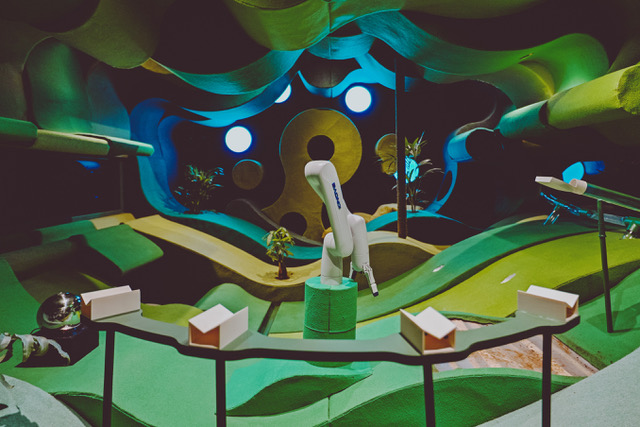Towards the tail end of last year, we were approached by the artists at Blast Theory to help with a set for their first work since 2019—Cat Royale, an exploration of AI and whether it can make cats happy. The idea was to build an interactive environment for cats to live in for a few hours a day while an AI-powered robot attempted to cater to their needs and learn, from their behaviour, things like which toys they preferred.
The set design was complex—it needed to be specifically appealing to cats, with limited flat surfaces, lots of hidey holes, and different obstacles for them to climb so they could exhibit as much of their natural behaviour as possible—while also being functional. The robot needed to move unimpeded, and the set also needed to be suitable for multiple cameras to be installed to capture the cats at all times, so animal behaviour experts could constantly monitor their wellbeing, and the filming and social media team could provide the internet with its favourite thing: lots of cat content.
With the rise of programmes like Chat GPT and the controversy surrounding AI art, it felt increasingly like a timely piece, and by March 2023, when the project went live, the questions that drove the work were more pressing than ever.
So, what did we learn about AI working on Cat Royale?
One of the most interesting initial findings was that the AI wanted to keep offering the cats treats, because the treats made the cats happiest. This had to be overridden by the cat behaviourists to ensure there wasn’t too much treat-based instant gratification, that the cats’ long-term wellbeing was considered, not just what would make them happiest in the moment. In making the choice to keep offering treats, the AI seemed to have fallen into a very human trap, one that almost any cat owner will be familiar with.
It leads us to the key consideration surrounding AI generally: how do—and can—we prevent it from just making the same mistakes, falling into the same traps, and replicating the same prejudices as the humans who invented and work with it? As we move into a world where AI is not just attempting to service the needs of cats in a highly controlled environment but serving our needs out in the wilds of the internet, how do we make sure it’s not just offering us the content equivalent of a seafood Dreamie? What happens if AI, in a quest to meet our needs, offers us too many dopamine and serotonin treats—like social media likes or outrage clickbait—which seem like what we want in the moment but aren’t necessarily good for us long-term? What does the world look like when writing or artwork is generated instantly to meet a perceived need and is consumed and forgotten more quickly than a cat can hunt and eat a kibble?
The scientific research part of the project is ongoing—cat poo is being analysed to provide measurable data on the happiness of the cats over the course of the project—but those key questions raised by Cat Royale are things everyone needs to consider, especially those of us who make work with public influence, whether that be as artists or marketeers.
If you want to know more about Cat Royale, you can watch our behind-the-scenes video, which features an interview with one of the artists, here: https://www.youtube.com/watch?v=NoR-8B4CRVE
Got a project requiring a similar level of thoughtful design (robots and cats not required)? Get in touch: anything@wemakestuffhappen.co.uk.





